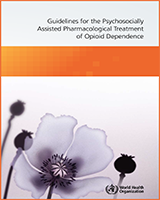All rights reserved. Publications of the World Health Organization can be obtained from WHO Press, World Health Organization, 20 Avenue Appia, 1211 Geneva 27, Switzerland (tel.: +41 22 791 3264; fax: +41 22 791 4857; e-mail: tni.ohw@sredrokoob). Requests for permission to reproduce or translate WHO publications – whether for sale or for noncommercial distribution – should be addressed to WHO Press, at the above address (fax: +41 22 791 4806; e-mail: tni.ohw@snoissimrep).
NCBI Bookshelf. A service of the National Library of Medicine, National Institutes of Health.
Guidelines for the Psychosocially Assisted Pharmacological Treatment of Opioid Dependence. Geneva: World Health Organization; 2009.

Guidelines for the Psychosocially Assisted Pharmacological Treatment of Opioid Dependence.
Show details| Substance | Primary mechanism of action | Behavioural effects | Tolerance | Withdrawal | Effects of prolonged use |
|---|---|---|---|---|---|
| Ethanol | Increases activity of GABA-A receptors | Sedation Impaired memory Motor incoordination Anxiolysis | Metabolic tolerance occurs due to enzyme induction Behavioural tolerance develops through learning Tolerance also develops through changes to GABA-A receptor | Shaking, perspiration, weakness, agitation, headache, nausea, vomiting Seizures Delirium tremens | Altered brain function and morphology Cognitive impairments Decreased brain volume |
| Hypnotics and sedatives | Benzodiazepines: facilitate GABA's opening of GABA-A chloride channel Barbiturates: bind to a specific site on the GABA ionophore and increase chloride conductance | Sedation Anaesthesia Motor incoordination Cognitive impairments Memory impairment | Develops rapidly to most effects (except anticonvulsant) due to changes in GABA-A receptor | Anxiety, arousal, restlessness, insomnia, excitability, seizures | Memory impairment |
| Nicotine | Nicotinic cholinergic receptor agonist Increases sodium inflow through the channel, causing depolarization | Arousal, increased attention; concentration and memory; decreased anxiety, decreased appetite, stimulant-like effects | Tolerance develops through metabolic factors, as well as receptor changes | Irritability, hostility, anxiety, dysphoria, depressed mood, decreased heart rate, increased appetite | Health effects due to smoking are well-documented Difficult to dissociate effects of nicotine from other components of tobacco |
| Opioids | Mu and delta opioid receptor agonists | Euphoria, analgesia, sedation, respiratory depression | Short-term and long-term receptor desensitization Adaptations in intracellular signalling mechanisms | Watering eyes, runny nose, yawning, sweating, restlessness, chills, cramps, muscle aches | Long-term changes in opioid receptors and peptides Adaptations in reward, learning, stress responses |
| Cannabinoids | CB1 receptor agonists | Relaxation, increased sensory awareness, decreased short-term memory, motor incoordination, analgesia, antiemetic and antiepileptic effects, increased appetite | Develops rapidly to most effects | Rare, perhaps due to long half-life of cannabinoids | Cognitive impairments, risk of relapse and exacerbation of mental illness |
| Cocaine | Monoamine (dopamine, norepinephrine, serotonin) transporter blocker (increases monoamines in synaptic cleft) | Increased alertness, energy, motor activity, feelings of competence; euphoria, anxiety, restlessness, paranoia | Perhaps short-term acute tolerance | Not much, except “post-high down” | Cognitive deficits, Abnormalities on PET with orbitofrontal cortex Impaired motor function Decreased reaction times EEG abnormalities Cerebral ischaemia, infarcts, haemorrhages |
| Amphetamines | Increased release of dopamine from nerve terminals via dopamine transporter not dependent upon action potentials Inhibits monoamine oxidase (MAO) | Increased alertness, arousal, energy, motor activity, speech, self-confidence, concentration, feelings of well-being; decreased hunger, increased heart rate, increased respiration, euphoria | Develops rapidly to behavioural and physiological effects | Fatigue, increased appetite, irritability, emotional depression, anxiety | Sleep disturbances, anxiety, decreased appetite, increased blood pressure; decreased brain dopamine, precursors, metabolites and receptors |
| Ecstasy | Blocks serotonin reuptake | Increased self-confidence, empathy, understanding, sensations of intimacy, increased communication, euphoria, increased energy | May develop in some individuals | Nausea, muscle stiffness, headache, loss of appetite, blurred vision, dry mouth, insomnia, depression, anxiety, fatigue, difficulty concentrating | Neurotoxic to brain serotonin systems, leads to behavioural and physiological consequences |
| Volatile solvents | Most likely GABA-A receptor mediated | Dizziness, disorientation, euphoria, light-headedness, increased mood, hallucinations, delusions, incoordination, visual disturbances, anxiolysis, sedation | Some tolerance develops (difficult to estimate) | Increased susceptibility to seizures | Changes in dopamine receptor binding and function Decreased cognitive function Psychiatric and neurological sequelae |
| Hallucinogens | Varies: LSD: serotonin autoreceptor agonist PCP: NMDA glutamate receptor antagonist Atropinics: muscarinic cholingergic receptor antagonists | Increased heart rate, blood pressure, body temperature; decreased appetite, nausea, vomiting, motor incoordination, papillary dilatation, hallucinations | Tolerance develops rapidly to physical and psychological effects | No evidence | Acute or chronic psychotic episodes, flashbacks or re-experiencing of drug effects long after drug use |
Source: WHO 2004[9]
- Summary of characteristics of selected psychoactive substances - Guidelines for ...Summary of characteristics of selected psychoactive substances - Guidelines for the Psychosocially Assisted Pharmacological Treatment of Opioid Dependence
- Heterospilus sp. BOLD-2016 voucher BIOUG10172-C07 cytochrome oxidase subunit 1 (...Heterospilus sp. BOLD-2016 voucher BIOUG10172-C07 cytochrome oxidase subunit 1 (COI) gene, partial cds; mitochondrialgi|1052457461|gnl|uoguelph|NGNAN335 COI-5P|gb|KR897421.1|Nucleotide
Your browsing activity is empty.
Activity recording is turned off.
See more...